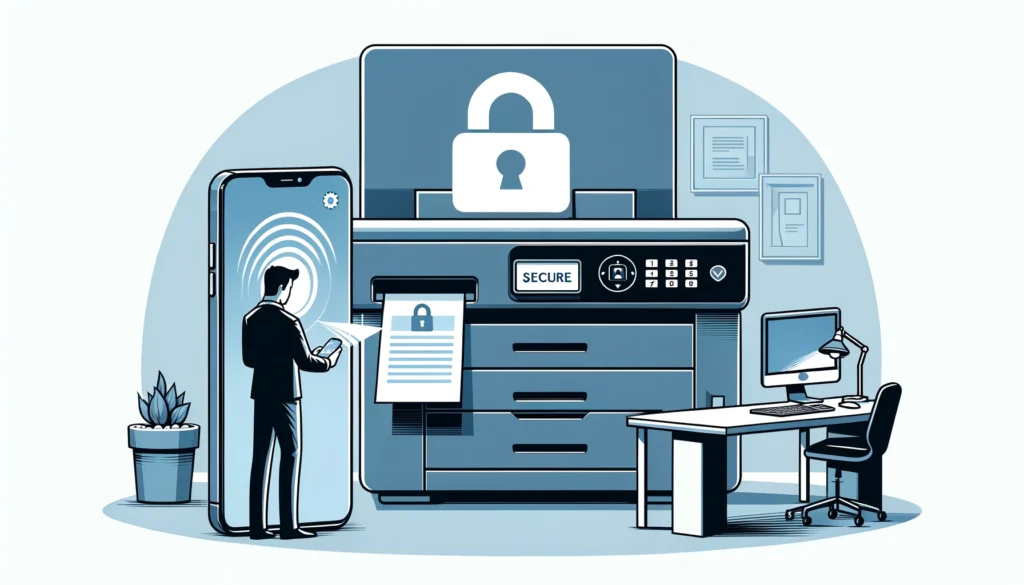Get Started now!
ezeep Blue is completely free for up to ten users. Sign up and get started with just a few clicks.
According to a study from the printer manufacturer Sharp (German), 1 in 5 SMBs in Germany identified a security breach which had some relationship to printer usage. Despite this, more than a third had not implemented any printing-related security measures. The “Global Print Security Landscape 2023″ report by Quocirca also highlights vulnerabilities in printing, particularly regarding home office printing and the integration of external output hardware, which Quocirca finds problematic. Both studies underscore the urgent necessity for companies to address the topic of secure printing.

Setting up secure printing means protecting confidential information throughout the printing process and afterward, a critical concern in sectors like finance, healthcare, and legal, where the confidentiality of printed materials is legally mandated.
So, what features should secure printing solutions have, and what security gaps do printers present? What should you consider regarding security when selecting your printing solution?
Full encryption of print data along the entire printing path is crucial for security. Solutions employing TLS 1.3 encryption are recommended, offering enhanced security through stronger cryptographic algorithms and reducing the risk of data interception, thereby bolstering data confidentiality and integrity. Additional security can be achieved by using a Connectivity Cloud, which secures access to services, websites, and APIs. Acting as a proxy, it also prevents malicious activities like DDOS attacks and enhances access speed through globally distributed entry points.

Secure printing setups must ensure prints don’t fall into the wrong hands. Pull Printing, or Follow-me Printing, stores print jobs in a secure network until the authorized user initiates the actual print at the printer, using RFID cards, smartphone apps, or QR codes for authentication. This approach not only prevents unauthorized access but also reduces paper waste as users print more consciously. Additionally, it allows users the flexibility to print from anywhere and retrieve documents from any authorized printer.
Print servers are cumbersome and challenging to maintain. A more straightforward and ultimately safer option is a print appliance like the ezeep Hub, which requires only outgoing connections to the ezeep Cloud (HTTPS/Secure WebSocket) and disables unused ports and protocols, preventing the introduction of malware-infected printer drivers. Rendering of print jobs in the ezeep Cloud closes a significant security gap.
The security of printing heavily relies on the data center processing the print data. It’s essential for the data center to comply with GDPR, favorably located within Europe. Inquiring about regular penetration tests and Microsoft certifications (such as ISO 27001/27002 for Azure, SOC 1, and SOC 2) is also prudent.
Zero Trust, put simply, is a security model where users must log into not just the network, but each individual application as well. This approach allows for regular verification of the accessing individual’s permissions. Thus, if an attacker manages to infiltrate the network, they would fail when trying to access specific applications. Printing in such an environment can quickly become problematic, as in a network adhering to Zero Trust principles, printers and application computers are in separate segments. Consequently, printers cannot be directly accessed from the application computer. Moreover, printing from home offices or remote workstations becomes difficult or even impossible. Therefore, those following a Zero Trust model should look for a solution that supports this concept on the printing side as well.
To ensure the security of the Zero Trust environment, it’s crucial to allow printer usage only with authorized access. Cloud printing solutions are recommended for this purpose, requiring users to authenticate with the cloud printing service, ideally via two-factor authentication.
For on-premises printing solutions, ensure regular security updates and keep your printers’ firmware up to date.
SSO, a user authentication service allowing access to multiple applications with a single set of credentials, enhances security by reducing the number of passwords, thereby decreasing the risk of password theft.
By focusing on these features, organizations can significantly enhance their printing security, protecting sensitive information from unauthorized access. The evolution of secure printing solutions is integral to safeguarding corporate data, emphasizing the importance of adopting comprehensive security measures in today’s digital and increasingly remote working environments.
Normally, printers are set up with all common communication protocols and interfaces such as Wi-Fi, Ethernet, and sometimes Bluetooth, SNMP, Bonjour, etc., activated by default. Our advice: Disable any protocols that are not needed, such as Bluetooth. Remember, each activated protocol could potentially be an entry point for malware and hackers. For instance, with ezeep Blue, printers can only be accessed through the ezeep Hub or the ezeep Connector.
Hard drives in printers should definitely be encrypted. For many manufacturers, this is a measure that is usually very easy to activate. Please never forget that these printer hard drives may store sensitive data. So, if you ever retire your printer, at the very least, the hard drive should be encrypted.
It’s crucial for companies to recognize the importance of print security and take appropriate measures to protect their data and network. Those who follow the criteria listed in this article are on the right path. ezeep Blue provides comprehensive protection for each security aspect mentioned above. For example, ezeep Blue supports secure pull printing, also referred to as follow-me printing. Another interesting feature is auto delete: unprinted documents can be automatically deleted after a period defined by the user. By default, ezeep is set to delete unused print data after 48 hours. Used print data is deleted immediately after printing.
The ezeep data center in Ireland is certified with ISO 27001/27002 (Azure), SOC 1, and SOC 2 (Azure), and conducts regular penetration tests. Printing in Zero Trust environments is also possible with ezeep Blue through the use of the ezeep Hub. The Hub independently establishes the connection between the cloud and printer, thus being the sole contact point for the printer.
The ezeep Hub can also equip home offices with printing functions very simply and securely, even in a Zero Trust model. For web applications, ezeep enables printing through its API or its JavaScript module, ezeep.js. You can download an eBook on Zero Trust printing with ezeep for free.
ezeep also addresses the issue of outdated, insecure drivers – a major security loophole in printers – by installing the virtual printer driver ThinPrint Output Gateway. This driver is used by default when assigning printers, thereby reducing the risk of malware installation through manipulated printer drivers or the exploitation of security vulnerabilities.
If you’re unsure whether ezeep Blue fits your requirements and security concept, do not hesitate to contact us.
ezeep Blue is completely free for up to ten users. Sign up and get started with just a few clicks.